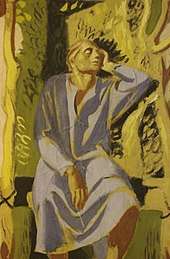St Elisabeth's Eastbourne
.jpg)


St Elisabeth’s church is a Grade II listed building in Eastbourne, Sussex, England.[1]
The church was built in 1935–1938 to the designs of local architects Stonham & Sons and Fenning.[2] The church is a good example of the architecture of the period and contains notable artworks. It is one of several sites across Sussex to benefit from the encouragement given to the arts by a previous Bishop of Chichester, George Bell (1883-1958).
The artworks at St Elisabeth's include chancel paintings by the art historian and conservator, Ernest William Tristram (1882-1952). Created in 1938, the Tristram Panels depict the life of John the Baptist and his parents, the priest Zacharias and his wife Elizabeth. Tristram is known for cataloguing and making watercolour paintings of existing church frescoes. However, Tristram also painted a limited number of original works, including the panels at St Elisabeth's and paintings at York Minster and St Fin Barre's Cathedral in Cork City.
In addition, St Elisabeth's crypt contains a series of large wall paintings by the artist Hans Feibusch (1898-1998). Feibusch was a Jewish refugee who fled Germany for Britain in the 1930s. His work was included in the Nazi-organised Degenerate Art Exhibition of 1937. In Britain, Feibusch became a member of the London Group and found his niche fulfilling commissions to paint murals in churches and other public buildings. Through this work he came to the attention of Charles Herbert Reilly, professor of architecture, and George Bell who provided Feinbusch with the opportunity to create a mural of his own design at St Elisabeth’s in 1944. Feibusch chose the allegory of Pilgrim's Progress as a vehicle for his own story as a refugee fleeing Nazi Germany and his eventual acceptance in 1940s Britain.[3] Feibusch enlisted the help of local people to complete the mural, which is now a registered War Memorial dedicated to civilian casualties of war.[4]
Structural flaws in St Elisabeth's church became apparent in 1943 and a bomb caused further damage during WWII. The building's deteriorating condition and the cost of repairs led to the church closing for worship in 2002, with the congregation continuing to meet in the church hall. The Church of England owns the building and in 2017/18 consulted on proposals to demolish the church and to move the Feibusch murals.[5]

References
- ↑ "Church of St Elisabeth". National Heritage List for England. Historic England. Retrieved 31 December 2017.
- ↑ Church of England, Church Commissioners (14 November 2017). "Mission and Pastoral Measure 2011, Closed Church Building of Eastbourne St Elisabeth Diocese of Chichester" (PDF). www.ccpastoral.org.uk. Retrieved 30 December 2017.
- ↑ Grey, Alex. "Save the Feibusch Mural". www.martyrs.gallery. Retrieved 30 December 2017.
- ↑ "St Elisabeth's Chapel WW2 Chapel of Remembrance". www.iwm.org.uk. Imperial War Museum. Retrieved 30 December 2017.
- ↑ The Church of England Church Commissioners (14 November 2017). "Mission and Pastoral Measure 2011, Closed Church Building of Eastbourne St Elisabeth Diocese of Chichester" (PDF). Retrieved 30 December 2017.
External links
